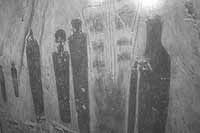| This mural of part of the Barrier Canyon panel hangs in the CEU Prehistoric Museum in Price. |
Utah is an extraordinarily rich state in terms of its archeological past. Native Americans have lived in every part of the state from extremely ancient times, and have left rock art reminders of their presence in all parts of the state. One of the oldest cultures in Utah is the widespread desert culture that had a continuity of basic form for nearly 10,000 years. In Utah this incredibly stable culture persisted until about 500 A.D. when it blended with, grew into, or was replaced by the Fremont Culture.
The culture that is characteristically, and almost exclusively, Utahn is this Fremont Culture which was first described by Noel Morss in 1931. It is perhaps best represented in the canyons to the east of the Wasatch Mountains from Vernal to the Colorado River, but evidence of it is found all over Utah, except for a small corner in San Juan County.
| Cottonwood Canyon leads up toward Peters Point from Nine Mile Canyon. Within this canyon lies many ancient panels and ruins, including the famous Great Hunt Panel. |
When it appeared is a much debated point, but about 500 A.D., the old hunting and gathering culture gave way to a partly farming culture which included some ideas from the Anasazi farmers to the south. Along with many other distinctive characteristics, the Fremont people developed their own art style.
This was typified by horned, trapezoidal-bodied anthropomorphs (human-like objects) which seem to have been made everywhere the Fremont people lived.
In the more prominent Fremont areas such as Nine Mile Canyon and sites in the San Rafael Swell these are large and have many elaborations such as necklaces, earrings, shields, swords, loin cloths and fancy headdresses. The Fremont people also developed a stylized way of making spirals, zig zags, scorpions, mountain sheep, deer, snakes and hunting scenes.
The late Lynn Fausett was born and reared in Price. He is a nationally famous artist who has won local acclaim for his paintings in the lobby of the Price Municipal Building.
In 1940, he did the “Barrier Canyon Murals” as a WPA Project. There are two separate canvases. The one on display in the College of Eastern Utah Prehistoric Museum is the smaller of two (12 x 22 ft.) and depicts approximately the left hand one-fourth of the Great Gallery. The other, larger canvas (12 x 80 ft.) hangs in the Utah Museum of Natural History at the University of Utah.

